Suan Pakkad Palace AMust-Visit Destination For Immersive Cultural Experience
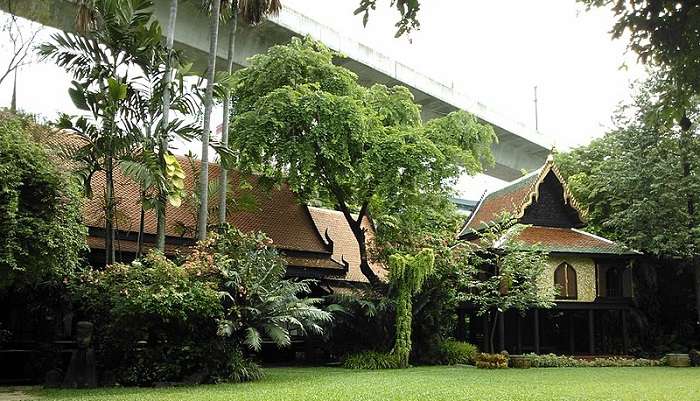
Explore the richness of Thai history, its vibrant culture, and its rich heritage at Suan Pakkad Palace! Bangkok, the country’s capital is known for its vibrant culinary scenes and grandeur of its temples. Amidst the city skyline, the magnificent skyscrapers, and the bustling markets, stepping into Suan Pakkad feels like a walk-through the time. Originally a private residence of the Thai Royals, Suan Pakkad Palace, is transformed into a museum that houses a range of heirlooms, artifacts, and pieces of art, which were passed down from their ancestors. Dive into this treasure trove where every antique narrates a story of its past glory.
Suan Pakkad Palace Museum Bangkok: Overview

Suan Pakkad literally translates to ‘Vegetable patch’ or ‘lettuce farm’. Originally a working lettuce farm, Prince Chumbhotbongs Paribatra and his wife, Princess Chumbon of Nakhon Sawan acquired the patch of land. Prince Chumbhotbongs Paribatra deeply appreciated and regarded Thai art and culture. He transformed the farm into a series of traditional Thai houses, making it a sanctuary that reflected his love for heritage. In 1952, Prince Chumbhot and Princess Chumbon went a step further and shared their private residence with the public and converted it into the Suan Pakkad Palace Museum. This generosity opened a window into Thai art, architecture, and history for generations.
Stepping into Suan Pakkad is like walking back in time. This museum is comprised of eight Thai houses, which showcase the beauty of Thai architecture. The usage of Teak wood dominates the construction. Its rich tones and detailed carvings add splendour and artistry. Sheltered walkways, known as “salas,” connect these houses, providing shade and a sense of flow between the different sections of the complex.
Must Read: Holiday Homes In Thailand
Suan Pakkad Palace: Artistic Delights And Natural Retreat
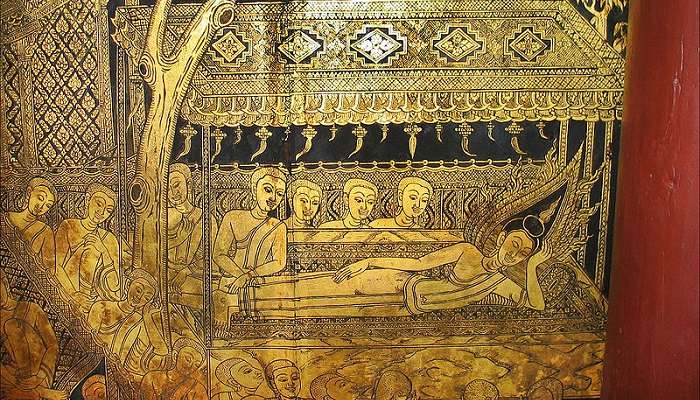
Suan Pakkad Palace’s charm is not just in the architecture—it goes beyond that! A fascinating collection of Thai antiques and art pieces makes Suan Pakkad even more interesting. Stroll through the different halls in awe to discover artefacts dating back centuries. The museum also boasts a dedicated room for the Marsi Gallery, showcasing contemporary Thai art.
Lush gardens, well-manicured lawns with ponds, and a variety of flora and fauna create a sense of tranquillity. Enjoy the peaceful haven, where the gentle sounds of birdsong and the rustling of leaves provide a soothing melody to the ears instead of the city’s cacophony. Keep an eye out for the resident ducks and swans, further enhancing the park’s beauty.
Suan Pakkad Palace: Artefact Showcase
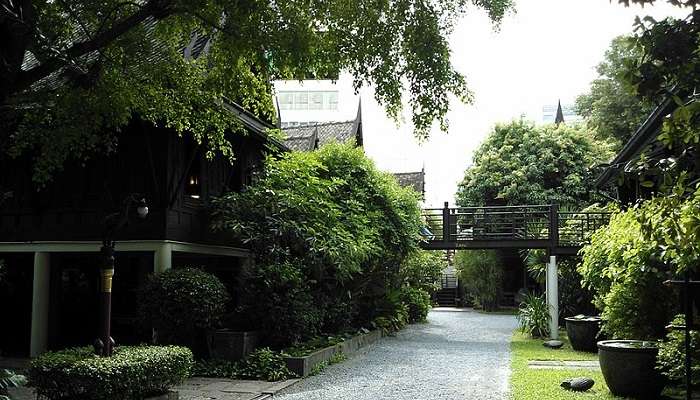
House 1: Old weaponry, including spears, pottery as old as the 14th century, artwork from the Ayutthaya period, and stone sculptures from Khmer.
House 2: Intricately crafted trays made of mother-of-pearl, and traditional storage cabinets
House 3: Objects made of Benjarong porcelain are displayed. This porcelain was popular with Thai royalty in the last century. Benjarong comprises five colours – black, white, red, green, and yellow.
House 4: A praying room consisting of Buddha idols, a royal dining space and a reception.
House 5: Ban Chiang pottery collection is placed here. Witness prehistoric Ban Chiang pottery spanning over 4,000 years and delightfully crafted bronzeware and ceramics.
House 6: Detailed carved figurines, costumes, and masks of the ancient art form of Khon dance are kept here. Khon dance is based on the epic Ramekin (Thai adaptation of the Indian epic Ramayana).
House 7: Rare Ceramic set collections from different dynasties of China are carefully preserved here.
House 8: Classy silver, porcelain and crystal heirlooms used by the Thai Royal family are stationed here.
Lacquer Pavilion: This single-story structure dates back to the Ayutthaya period and is adorned with exquisite lacquer work depicting Thai mythology and folklore scenes. Originally built in the 17th century, this house was carefully dismantled, repaired, painstakingly rebuilt, and restored in Suan Pakkad. This astonishingly beautiful restored house was gifted by Prince Chumbot to his wife in 1959.
Salas: Divided into two groups connected by covered walkways, these houses showcase the elegance of vernacular Thai architecture. Natural ventilation and flood prevention is done by elevating the houses on the teak stilts. Each house boasts its own charm, with lavish carvings and porticos showcasing complex details and craftsmanship. Decorative elements like nacre inlay and vibrant murals often adorn the interiors, offering a glimpse into the traditional living spaces of the past.
Suggested Read: Festivals In Thailand
Nearby Attractions To Suan Pakkad Palace
After exploring the insights of Suan Pakkad Place, it is essential to visit the nearby top attractions. Here are some must-see places when visiting Suan Pakkad Palace:
1. Wat Suthat
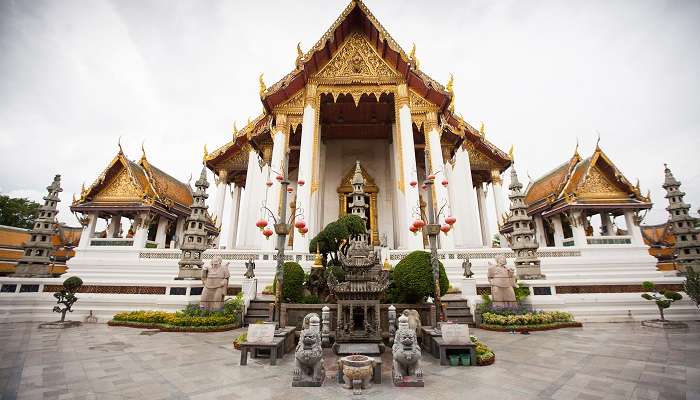
A first grade Royal Temple, the construction of Wat Suthat dates to 1807 – 1847 during the reign of King Rama I but was completed only during the rule of King Rama III. With a remarkable architectural feature, the temple boasts a grand praying hall adorned with splendid murals of Buddha and intricately carved teak doors, and an 8 m tall Buddha image is housed in the Viharn of the prayer hall.
Opening hours: 8.30 am – 9.00 pm.
Entry fee: 20 Thai Baht.
Distance from Suan Pakkad Palace: 5.0 km approx.
2. Golden Buddha Temple (Wat Traimit)
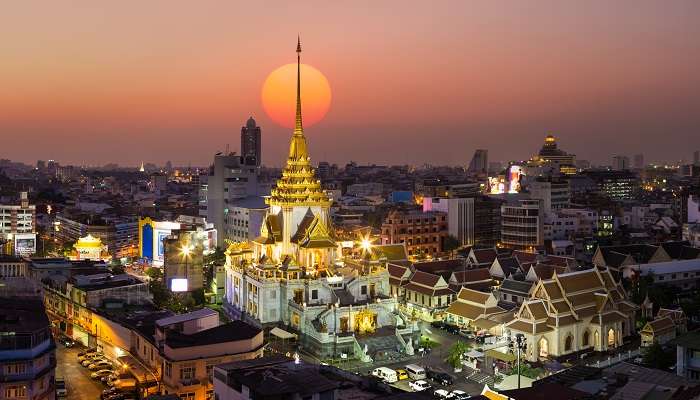
Also known as Golden Buddha Temple, Wat Traimit holds the giant and most precious Buddha statue in the world. Standing 10 ft tall, this Golden Buddha statue weighs 5.5 tons with 83% gold. Many tourists and devotees come to this temple for the splendid view of the Buddha. The temple also houses a museum which provides information about the statue’s history and construction.
Opening hours: 8.00 am – 5.00 pm.
Entry fee: 100 Thai Baht + 40.00 Thai Baht for visiting the museum.
Distance from Suan Pakkad Palace: 5.0 km approx.
Suggested Read: Things To Do In Bangkok In 5 Days
3. Wat Mangkon Kamalawat
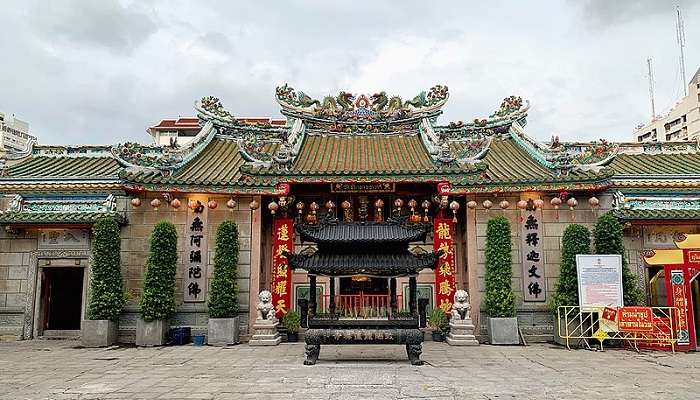
Built-in 1871 by Phra Archan Chin Awang Samatiwat, Wat Mangkon Kamalawat Temple is one of the oldest and most popular Buddhist temples in bustling China Town, Bangkok. Locals come here to perform their prayers regularly, but the temple is in its full glory at the time of the Lunar New Year and the Annual Vegetarian Festival. Tourists, visitors, and devotees from all corners of the Asian continent gather here to participate and experience these major festivities.
Opening hours: 8.00 am – 6.00 pm.
Entry fee: Free
Distance from Suan Pakkad Palace: 6.0 km approx.
4. Wat Benchamabophit Dusit Wanaram
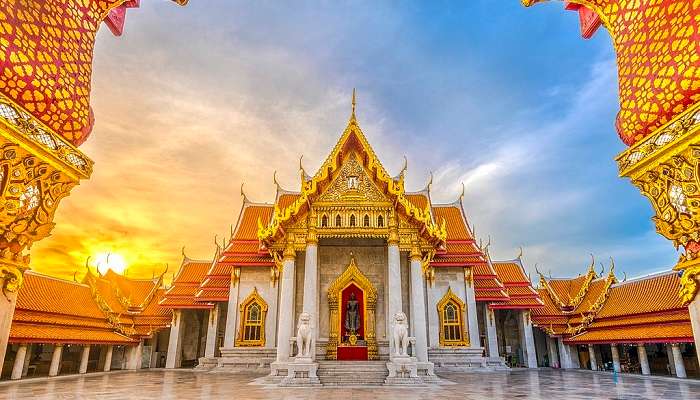
Also known as The Marble Temple, Wat Benchamabophit is one of the major tourist attractions in Bangkok. The temple’s construction began in 1899 under the reign of King Chulalongkorn. The main design of the temple is done by the King’s half-brother, Prince Naris. Italian marble is used mainly in constructing the temple, including the pillars, the courtyard, and the two big lion statues standing at the entrance of the temple complex. The interiors are adorned in Gold and lacquer, giving the temple a classy look.
Opening hours: 8.00 am – 5.00 pm.
Entry fee: 50 Thai Baht
Distance from Suan Pakkad Palace: 2.8 km approx.
Suggested Read: Emerald Pool Karabi
Tips When Taking A Tour Of Suan Pakkad Palace:
The tour to Suan Pakkad involves a lot of walking, so wear comfortable footwear and light clothing. If you want to view the insides of the houses, remove your shoes. In that case, a plastic bag will be given to carry the shoes! Food and beverages are prohibited inside the palace, but you can always carry a water bottle to keep yourself hydrated. Also, there are various cafes and restaurants near the palace.
Further Read: Places To Visit In Bangkok
Whether you are a history lover, an art aficionado, or simply a traveller seeking to delve deeper into the heart of Thailand’s cultural identity, a visit to Suan Pakkad Palace Museum promises an unforgettable experience. If this detailed guide on the Museum draws you to it, then book a trip to Bangkok today. We assure you that your journey to the Suan Pakkad Palace Museum will be a memorable one.
For our editorial codes of conduct and copyright disclaimer, please click here.
Cover Image Credit: Kasom SKULTAB for Wikimedia Common
Frequently Asked Questions About Suan Pakkad Palace
What is the Suan Pakkad Palace entrance fee?
Suan Pakkad Palace entrance fee for foreign visitors is 100 Baht and for the locals it is 50 Baht. You can take the tickets at at the designated ticket counter available at the entrance.
What is Suan Pakkad Palace visiting hours?
The museum is open from 9.00 am to 4.00 pm. Tourist can only visit the museums during this time so plan your trip accordingly.
Is photography allowed in Suan Pakkad Palace Museum Bangkok?
Photography is allowed in the lawns and exteriors, no photography inside the Thai houses. Photography is prohibited because museums display the prehistoric artefacts from Ban Chiang, that is essential.
How to reach Suan Pakkad Palace?
To reach Suan Pakkad Palace Museum via BTS Skytrain, disembark at Phaya Thai station and head towards Exit 4. Alternatively, buses numbered 14, 17, 72, 74, 77, 204, and 539 all pass by the museum.
What are the nearby cafes and restaurants from Suan Pakkad Palace?
The Pasta Apartment Silom, Lin-Fa Chinese Restaurant, Patummat Restaurant - The Sukosol Hotel, Spicy Hut and Fretta Cafe are a few restaurants and cafes near Suan Pakkad Palace Museum Bangkok.
People Also Read:
Museums In Munich Museums In Bulgaria Museums In Portugal

Unveil the hidden treasures of the globe and turn every travel dream into reality. As a Content Writer, I am passionate enough to craft stories from ancient wonders to modern marvels. My words paint the picture-perfect itinerary for unforgettable experiences. Let my words be your trusted guide to immerse in the diverse culture and discover the beauty of the unknown.











